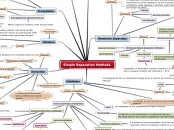von Zubaydah Abdullah Vor 12 Jahren
851
Simple Separation Methods

von Zubaydah Abdullah Vor 12 Jahren
851

Mehr dazu
HPLC
separated on a packed or capillary column
Azeotropic/Extractive distillation
Example
Formation of two immiscible liquid phases by addition of benzene to water and ethanol.
To separate mixtures whose components boil too close together for economic fractional distillation.
Adding another component to alter the relative volatility of the mixture substances and form lower-boiling azeotrope that is heterogeneous.
Any technique used to break an azeotrope (mixtures that are difficult to separate) in distillation.
steam distillation
The mixture boiling point tempreture is reduced by vaporixing it into a stream of carrier vapor
vacuum distillation
Applications
To separate
materials that decompose below their normal boiling points.
high-boiling mixtures.
It is distillation under decreased pressure to reduces the boiling temperatures.
Flash distillation
It is instantaneous and continuous vaporization of a definite fraction of the liquid mixture in such a way that the total vapor produced is in equilibrium with the residual liquid.
Fractional distillation
It is based on the condensation of the hot vapor at verious levels in the column and the resulting liquid refluxes to a lower level where it is vaporized, which corresponds roughly to a re- distillation.
It depends on the distribution of constituents between the liquid mixture and vapor in equilibrium with the mixture.
less volatile ones are in greater concentration in the liquid.
more volatile components concentrated in the vapor
for separation of the components of liquid mixtures.
sublimation (highly specialized distillation method), is used to volatilize their component if possible .
method of multiple liquid-liquid extractions is countercurrent extraction, which permits the separation of substances with different distribution coefficients (ratios)
Using gravitational force to separate solids from the liquid.
Using simple filter papers (made from cellulose) and exhibit particle retention levels down to 2.5 μm.
Using Membrane Filters
Using Buchner funnel
Mainly organic & inorganic weak acids & bases
Common ion effect
Addition of a species that form a lower solubility salt with the target species.
Addition of another miscible solvent to the solution which lower the solubility of the component of interest
Electrodialysis
Ultra filtration
The process
Application of hydrostatic pressure between 1 & 10 atm to separate solutes with diameters > 20 Aْ
Various semipermeable membranes
Charged Membranes
The separation is accomplished by:
exclusion of coions (ions of the same charge as The fixed ions) from the membrane
pore size as well as
Thin Membranes
The thinner the membrane; the faster the transport rates through membranes.
Homogeneous Membranes
Particles of exactly the same size can be separated with homogeneous diffusive-type membranes when their solubilities in the film or their concentrations differ significantly
Composition
a homogeneous film or interphase through which a mixture of chemical species can be carried by molecular diffusion
Microporous Membranes
The principle
intermediate pore size -> partially rejected
<< pore size -> allowed to pass
If the size of particles (or molecules): >>pores sizes -> rejected to pass
Separate particles that differ significantly in size.
General important properties of membranes
Good chemical stability.
Good mechanical stability